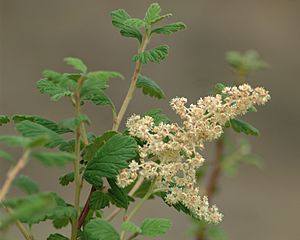Holodiscus dumosus facts for kids
Quick facts for kids Holodiscus dumosus |
|
|---|---|
 |
|
| Conservation status | |
| Scientific classification | |
| Genus: |
Holodiscus
|
| Species: |
dumosus
|
Holodiscus dumosus is a cool plant from the rose family. It has a few fun common names like mountain spray, rock-spiraea, bush oceanspray, and glandular oceanspray. This plant is a type of shrub that grows in many parts of North America.
Contents
Where It Grows
This plant is found in western North America. You can see it in northern Mexico and across the Western United States. It likes to grow in many kinds of forests and shrublands. For example, it is often found in Douglas-fir and Ponderosa pine forests. It can grow from about 3,000 to 11,900 feet (900 to 3,600 meters) high. This depends on how far north or south it is and the local weather.
In states like Colorado, New Mexico, Wyoming, and Idaho, you can find it in the Rocky Mountains. It is very common in Utah. In Arizona, it grows in mountain areas like the Chiricahua Mountains. It is also a common plant in the amazing Grand Canyon. In Nevada, it grows with quaking aspen trees and willows. You can also find it in northern California and Texas. In Mexico, it lives in the states of Chihuahua and Baja California.
Its Favorite Spots
This shrub can grow in many types of soil. It can even grow on bare rock or in cracks in cliffs. It can handle dry weather, but it really likes places that are a bit more wet. It can grow in cooler, moist mountain forests. It prefers spots that are sheltered from direct sunlight and strong winds. It can easily anchor itself on steep hillsides. It can even grow on vertical cliffs!
What It Looks Like
Holodiscus dumosus is a deciduous shrub. This means it loses its leaves in the fall. It can grow from about 1.6 to 20 feet (0.5 to 6 meters) tall. It can spread out from 5 to 10 feet (1.5 to 3 meters) wide. Its branches grow out from the base of the plant. The bark on the branches is shreddy. The smaller, reddish twigs might have tiny spines.
Leaves and Flowers
The leaves are about 2.3 centimeters (almost an inch) long. They are about 1.2 centimeters (half an inch) wide. They have a nice smell. The leaves have lobes or teeth along their edges.
The plant produces many small, pinkish-white to cream-colored flowers. They grow in a feathery cluster called a panicle. Each tiny flower is only about 2 millimeters long. They bloom from June through August. Insects help to pollinate these flowers.
Reproduction
After blooming, the plant makes tiny, dry capsules. These capsules hold small seeds. The wind helps to spread these seeds around. The plant can grow new plants from its seeds. It can also sprout new growth from its root crown.
Different Kinds of Holodiscus dumosus
There are a few different types, or varieties, of Holodiscus dumosus:
- Holodiscus dumosus var. cedrorus: This type only grows in special serpentine soils. You can find it in The Cedars area of Sonoma County, California.
- Holodiscus dumosus var. dumosus: This is the most common type. It grows in Colorado, Arizona, Nevada, and Utah.
How People Use It
Native American peoples used this plant for different things. For example, the Paiute and Shoshoni people used it as a traditional medicinal plant. They used it to help with things like stomachaches and colds.
Early explorers who came to North America also found a use for the wood. They used it to make nails!
Growing It in Gardens
Holodiscus dumosus is also grown as an ornamental plant. This means people plant it because it looks nice. It is often used in wildlife gardens. These gardens are designed to attract animals. It is also used in natural landscaping projects. You can even grow it in a large pot!


